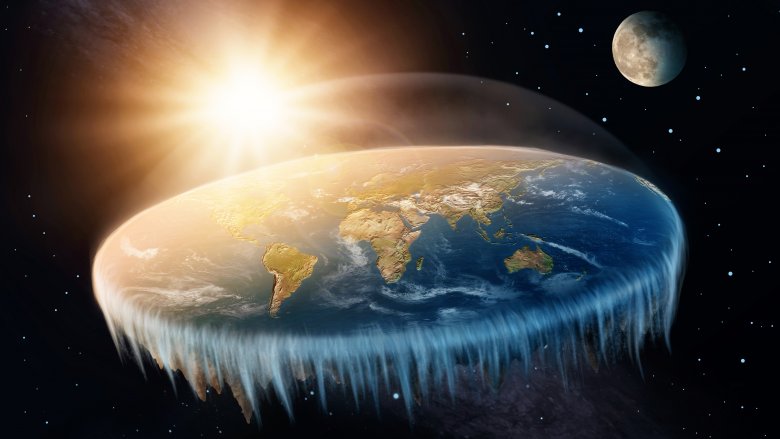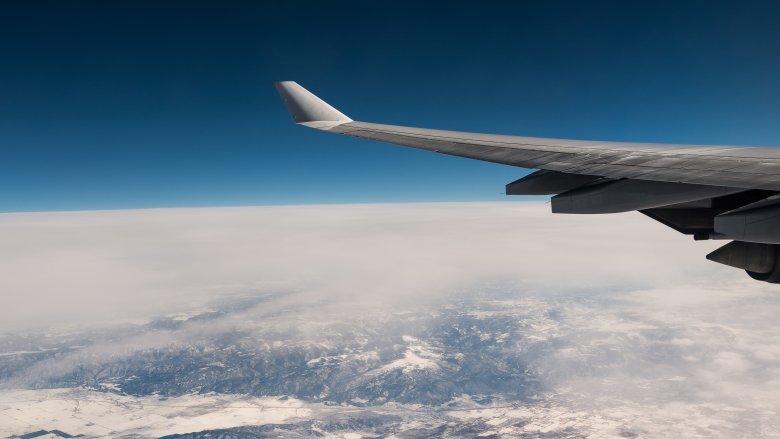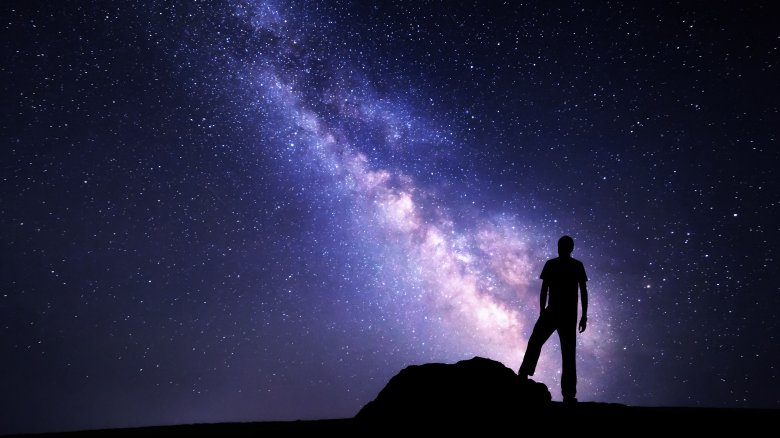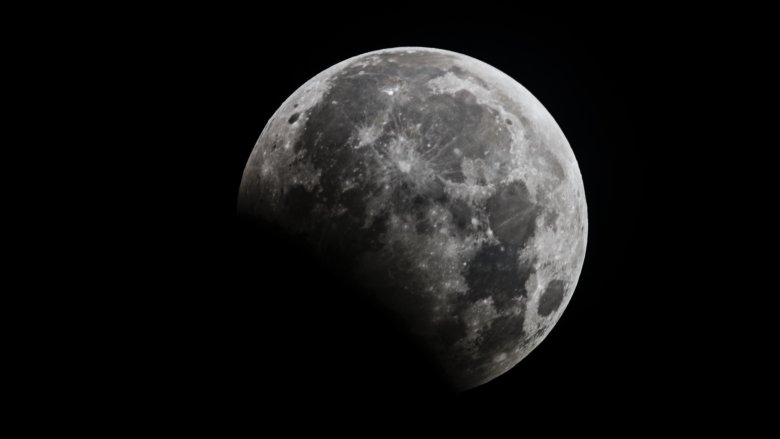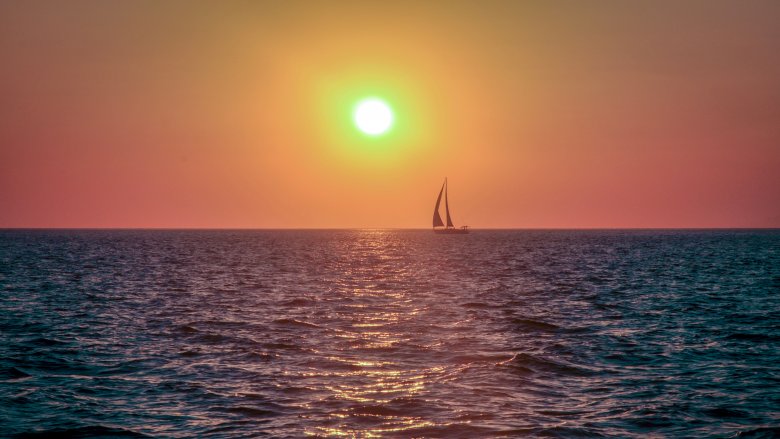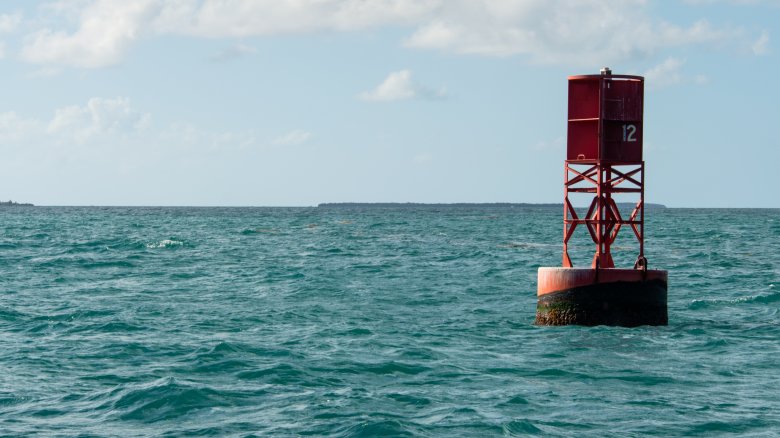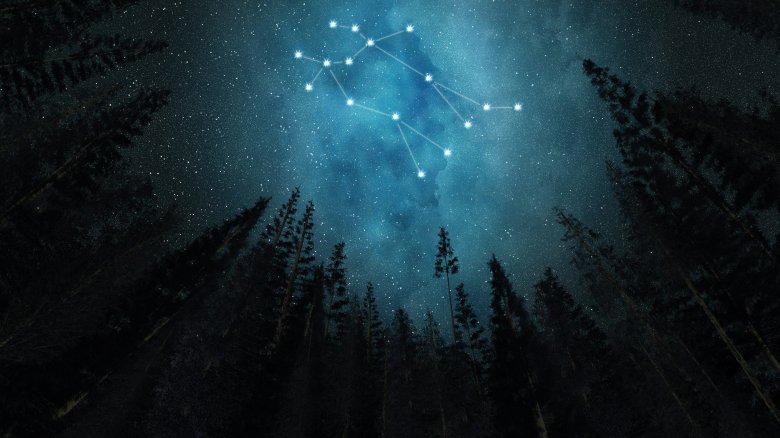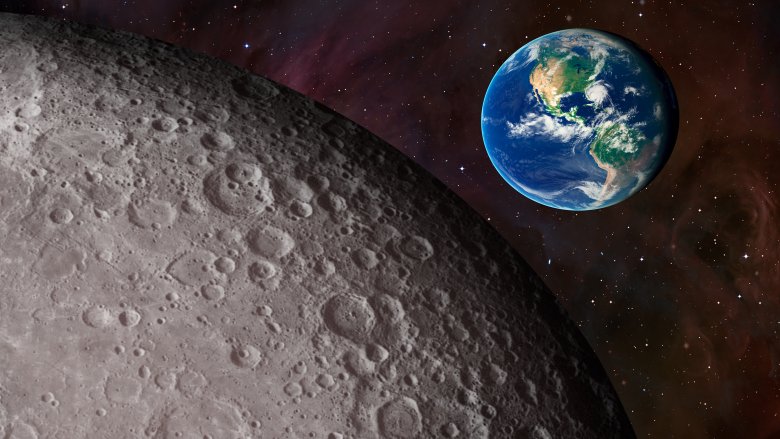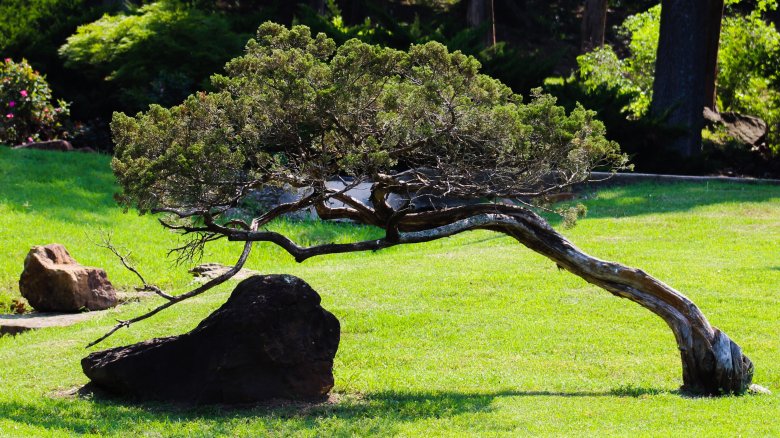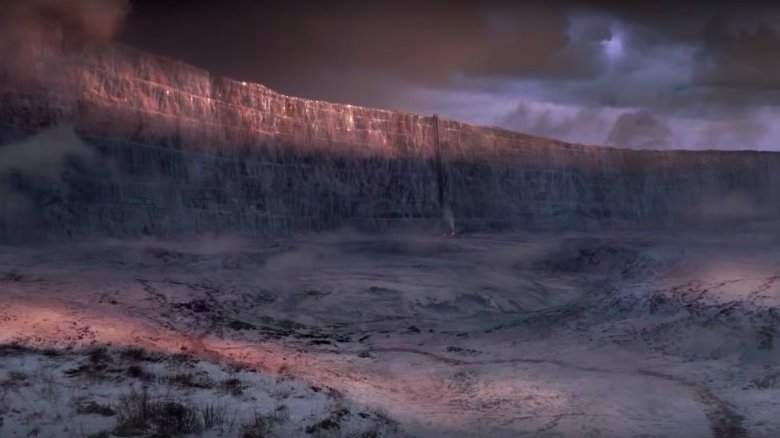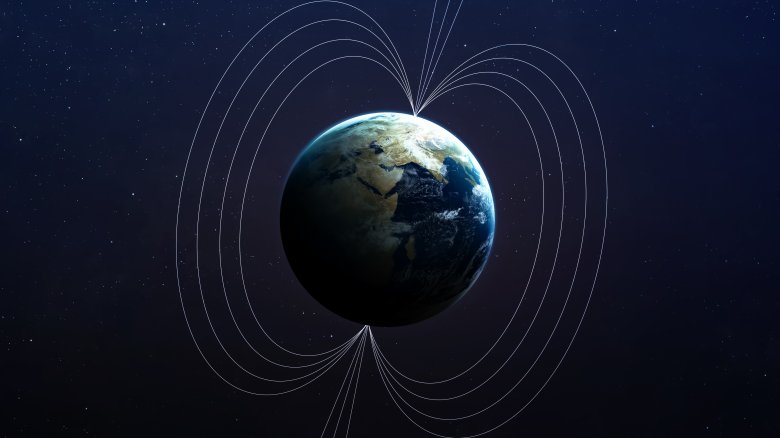What Earth Would Be Like If It Were Actually Flat
One of the great lies told to schoolchildren is that the whole round-earth thing was first proposed by Christopher Columbus, who was taking what he thought was a huge gamble when he decided to sail toward the edge of the Earth in hopes of encountering India. The truth is Columbus knew exactly what he was doing because humans have been aware of the shape of the Earth for centuries — millennia, actually. The ancient Greeks knew the Earth was round all the way back to Aristotle in 350 B.C. And Aristotle wasn't exactly the lone outlier, either. A Greek mathematician named Eratosthenes actually got pretty close to the real circumference of the Earth by comparing the distance between two cities and then measuring the position of the noontime sun at each location.
Now it is probably true that lesser-educated people still continued to nurse the notion that the Earth was flat, just as it's true today that certain mostly educated people for some reason have convinced themselves that the idea of a round Earth is merely some ginormous conspiracy to, um ... ??? To do something. Anyway, it's pretty clear that the Earth is round, despite what basketball players and rappers might have to say on the subject. Because if it weren't, the world would be a really strange place. Here's what would happen if the Earth were flat.
But first, a primer on insanity
Flat Earthers call their ideas a "model," because that does make it sound all valid and science-y. What it really is, though, is a fine, shining example of whackjobedness. The basic idea boils down to this: The Earth is flat, and all evidence to the contrary is either fake or just grossly misinterpreted.
So how exactly does a flat Earth function? Well, first of all, other planets are planets but the Earth isn't a planet, and it sits at the center of the solar system, and all the actual planets circle around it for reasons that really aren't very clear. The North Pole is in the middle of the disk (like if you viewed a globe from the top and then flattened it), and there's a wall of ice all the way around the outside. (This is maybe Antarctica, just really stretched out?) The Sun doesn't rise and set, it more shines down like a spotlight and points at different parts of the Earth through the day. Oh and what we perceive to be sunrise and sunset is really just a "perspective effect," whatever that means.
So what about all the visual proof, like photos and the testimony of people who have seen the Earth from space? Fake, fake, fake. NASA made the whole Moon landing up to stick it to the Russians and expert photoshoppers are responsible for all those fake images. And of course there's more, much more, but we'll just let you read on. Are you buckled in?
You would actually not fall off the edge
Gravity, according to NASA, is "the force by which a planet or other body draws objects towards its center." Because the Earth is a ball, all things on its surface are drawn in the same direction: straight down. Incidentally, gravity would also totally preclude the Earth actually being flat because it would eventually make the planet collapse into a spherical shape (which is why all planets are spheres), but never mind. Let's say for some reason the Earth kept its flat shape and gravity continued to do its thing. If you were in the center of the Earth-disk (which most flat Earth maps say is the North Pole), you'd experience gravity pretty much the way we experience it on our round Earth. But as you got closer to the edges, things would get weird.
According to Vsauce, approaching the edge would be like walking up a progressively steeper hill, even though you'd be on flat ground. That's because gravity would pull you towards the disk's center. So really, you wouldn't have to worry so much about falling off the edge as you'd have to worry about falling backward. And if you did get to the edge you could actually walk over it and stand perpendicular to the flat surface — gravity there would be pretty normal since you'd be directly above the Earth's center. So the most valuable real estate on a flat Earth? The center and the thin edge. Who knew?
There would be seriously lame lunar eclipse parties
One of the most obvious clues about the shape of the Earth is something the ancient Greeks noticed a long time ago — when there's a lunar eclipse, the shadow that passes across the Moon is round. Because the Earth is rotating, that shadow would only be possible if the Earth were a sphere.
If the Earth were flat, lunar eclipses would be really boring. Boring, and actually kind of ugly. If you're wondering how ugly, just picture the Moon with a thin strip of shadow down the center. Just a big ol' stripe shadow. If we actually did see eclipses like that, it's probably fair to say that no one would ever have a lunar eclipse viewing party because a lunar eclipse viewing party would be like the lamest party of all time.
Approaching ships would just sort of blink into view
In Pirates of the Caribbean, the Flying Dutchman rises out of the water and then its weird crew of slimy sea monsters boards whatever hapless ship is nearby and forces the crew into a century of creepy servitude, which among other things includes guarding a still-beating heart in a box and growing barnacles all over themselves. Popular Science points out that, when viewed from the shore, all ships appear to be emerging from beneath the waves. But alas, when they arrive at port, they are not dripping with seaweed and there are no barnacle-covered crewmen, so there must be a different explanation for what we observe as they approach.
If the Earth were flat, ships would not seem to emerge from the waves — they would just sort of blink into sight as they got closer. But what we actually see is the top of the ship first, and then the rest of it eventually follows as the ship gets closer. This is easy to observe with a tall sailing ship in particular because you can see the sails before you see the hull.
There are really only two possible explanations for what we are seeing: Either the Earth is round, or the Flying Dutchman is coming to get us. If you're not sure, you should pack some anti-barnacle cream in a go-bag, just in case.
Sports would get weird
On a flat Earth, we would need most of our sporting events to happen in the middle of the planet, where gravity behaves pretty much like it behaves on a round Earth. If you thought sitting at Green Bay's Lambeau Field in December was a miserable experience, try watching a football game at the North Pole.
For less freezing-cold viewing experiences, you would need to head for the edges of the disk — but sporting arenas located closer to the edges would make ball-oriented sports sort of complicated because when a player throws the ball toward the edges of flat Earth, it will go all wonky.
According to Business Insider, a ball thrown straight up would end up falling backward toward wherever the center of the disk is oriented. And you could throw that ball a lot farther toward the center of the disk if you were standing at the edges than you could if you were standing at the center because at the edges of the disk gravity won't have much downward pull. And there's also the problem of what would happen if a player accidentally threw the ball beyond the edge of the Earth, which would not only be the most complicated out-of-bounds ball of all time, it would also potentially hit the head of the turtle that everyone knows is swimming around space with the Earth on its back, and no one wants to upset the mother turtle. Bad things will happen.
The Earth's geography would be really different
So if the Earth were flat, and if we assumed the typical flat Earth map was more or less accurate, then we already have the uber weirdness of the North Pole being the most normal place on the planet. So the land of snow, ice, elves, and flying reindeer would be the only spot on the planet where gravity would function normally. But that would be only part of the weirdness.
Without the whole top of the world/bottom of the world thing, there really wouldn't be any reason why the North Pole would be the land of snow and ice, and if it weren't the land of snow and ice the elves and the flying reindeer would probably head for the giant wall of ice on the edge of the world so they could avoid the tourists and throngs of people pouring into the North Pole. Not only that, the North Pole would likely be a very wet place, because according to Business Insider, the skewed gravity would make it impossible for any water to exist at the planet's edges. So all the water on Earth would flow to the center, making the only normal place on Earth essentially uninhabitable unless you're Kevin Costner in that one movie that no one saw. On the plus side, Elon Musk would do a brisk business in Mars transportation since no one would really want to live on Earth.
Astrophysicists wouldn't be nearly so smug
One of the dead giveaways for the shape of the Earth is the behavior of the stars in the sky. This is such a dead giveaway that the ancient Greeks — while they were literally still wiping their butts with the softest rocks they could find — were smart enough to figure out that you wouldn't see different stars in different parts of the world unless the Earth were actually round. According to Popular Science, Aristotle made note of this phenomenon after a trip to Egypt: "There are stars seen in Egypt and ... Cyprus which are not seen in the northerly regions." He then went on to conclude that the Earth must actually be pretty small since the phenomenon was observable after traveling only a short distance.
On a flat Earth, you would be able to see the same stars at the North Pole as you would be able to see on the edge of the planet. You'd also be able to see Polaris (the North Star) while standing on the ice wall at the edge of the Earth — which basically corresponds to Antarctica on the flat Earth map, where Polaris is most definitely not visible. And also, astrophysicists wouldn't be nearly so smug, because they'd be wrong about pretty much everything.
Pink Floyd's eighth album would have a really stupid name
In the flat Earth model, the Moon is about 3,000 miles away from Earth, which is roughly the same as the distance between Chicken, Alaska and Atlanta, Georgia. So the Moon would have to be really small — like 32 miles wide — to look the way it does from Earth. But the other thing that would happen if the Earth were flat is that we wouldn't be locked into seeing only one side of the Moon — all sides would become visible at certain points throughout the day. In fact, depending where you stood on the Earth, you'd see a different part of the Moon than people looking at it from elsewhere on the planet. Metabunk gives us this example: If the Moon were halfway between Africa and South America, the 130-degree difference in viewing angle would mean that people on the two continents would see opposite sides of the Moon.
Perhaps more importantly, Pink Floyd would never have released Dark Side of the Moon because there wouldn't really be a dark side of the Moon and the metaphor wouldn't make any sense. And would we really want to live in a world where Pink Floyd albums are named That one part of the moon that we can sometimes see but is sometimes only visible to people in Africa? That would just be stupid.
Neighborhoods on the edges of the disk would be really weird looking
On a world where gravity is all mucked up at the edges, there would be some strange-looking forests — that is if you completely leave out the part where there wouldn't be any water on the edges of the Earth because gravity would pull it all back to the middle of the disk. But anyway, if the trees were somehow able to pull water out of the air (and let's face it, on a flat Earth anything is possible) or maybe just didn't need water at all because like human breatharians, they can survive on nothing but the energy of the universe, they would all grow at a very strange angle. According to the Earth Institute, trees grow opposite from the pull of gravity, so on those extreme outer edges of the planet, where gravity is pulling everything at an angle, back toward the center, the trees would actually grow diagonally.
This would make for really funky-looking neighborhoods since we'd also be building houses and other buildings to compensate for the strange pull of gravity. We'd have to build sloping concrete platforms for all our buildings so the occupants would feel the pull of gravity straight down instead of at an angle. And with all those diagonally sloping trees, crooked flower beds, and pedestrians who are constantly having to fight gravity just to get a Starbucks, human neighborhoods would be really bizarre places.
Traveling to the edge of the Earth would be a thing
Most flat Earth models say there's an ice wall that surrounds the planet, which may or may not be guarded by roving bands of NASA employees and Jon Snow, and may or may not have White Walkers on the other side. At any rate, the ice wall would be so massive that, like America's southern border, it would be impossible for ICE agents (har har) to survey the entire length of it 24 hours a day, 365 days a year.
Knowing how humans are about extreme physical challenges — like trying to climb to the top of Mount Everest despite knowing that the place is littered with the corpses of those who didn't make it — does anyone truly believe that it has never occurred to anyone anywhere on planet Earth to journey to the edges of the planet, climb the ice wall, and see what's on the other side? On a flat Earth, not only would climbing the ice wall totally be a thing, but you wouldn't be able to escape from all the live-streamed stories of adventures to the wall. Think about it — Facebook pages would be insufferable and Instagram would be the most annoying app ever.
Regardless, there's just no way the ice wall would remain unseen at this point in human history, not to mention everything else that would turn out to be totally fabricated, like all the times that human beings actually did cross Antarctica.
You would still be able to see the Sun at night
So how exactly does the Sun work on a flat Earth? For a start, it would be much smaller and much closer to the planet, just like the Moon on a flat Earth. But if the Earth weren't a sphere, then the Sun would have to act pretty much the same way a spotlight acts on a stage — sending directional light down at those parts of the Earth that are experiencing daylight, while leaving the rest of the world in darkness.
According to The Hub, the problem with this theory is that even if you're not directly underneath a spotlight, it's still visible to you. If you're in a darkened theater, you can see where a beam of light lands, and you can see the light source, too. So if the Sun really did function as a spotlight, you'd be able to look out the window and see it out there in the sky at any time of the day and at any time of the night, too — and it would look seriously creepy, like an alien spacecraft targeting distant cows with its giant tractor beam. Which would be sort of cool, if you had a good imagination. After all, who hasn't occasionally longed to watch cows slip the surly bonds of Earth?
Life on Earth wouldn't be possible anyway, so there's that
So all of this is assuming that the Earth would even still exist, if it had formed as a flat disk instead of a globe, and if it did, that life would even be possible here. Because our round Earth has a magnetic field and the Earth Institute tells us that the planet's magnetic field is generated in its core. On a flat Earth, there would have to be something else, like a subsurface ocean of liquid metal, that could stand in for the Earth's solid core. But even then, an ocean of liquid metal wouldn't rotate, so it wouldn't create a magnetic field.
So that means the Earth would be vulnerable to the Sun's charged particles, which would rain down on the planet and destroy the atmosphere. And then, the air and water would all fly out into space, which would really make everything else we've been talking about totally irrelevant. Crooked trees, funky soccer balls, Pink Floyd's eighth album, and the smugness of astrophysicists would all cease to matter because life on Earth wouldn't be possible anyway.
All scientists would turn out to be liars who are really, really good at keeping secrets
Finally, every scientist and politician on Earth would have to be a sociopathic liar engaged in the world's most intricately articulated conspiracy, one that has not only lasted thousands of years but has involved millions of people, and has somehow in all that time not suffered from a single information leak or drunken confession. This conspiracy would have to include Jon Snow and those NASA employees who guard the ice wall, and it would also have to include every scientist who ever lived, every supposed astronaut, every person who has ever been involved in any space mission, all the way down to the people who manufacture GPS devices, which would somehow have to be designed to convince pilots they're flying from east to west when they're actually flying in circles above a flat disk. And this massive, worldwide conspiracy would have to be so impenetrable that not a single truth-seeker could infiltrate it.
And let's say that the conspiracy did fall apart one day — as The Hub points out, we'd no longer be able to trust anything science, government, or astrophysicists have ever told us. And never mind that none of this answers the big, overarching question: Why? What exactly does science have to gain from lying to us about the shape of the Earth? Without an answer to that question, everything else becomes moot anyway.
